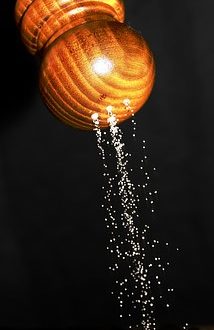
The amount of salt you should be eating depends on what kind of salt you use. Sea salt and Pink Himalayan Salt contain about 80 important minerals including potassium, calcium, magnesium, iodine, iron, and zinc. Table salt is heavily refined and has none of the mineral benefits of the other salts.
However, many people may have been told by their doctor to reduce salt use in their diet. In that case, you need to be aware of the foods which have naturally high levels of salt within them. These include avocado, cooked spinach, sweet potato or kumara, butternut squash, acorn squash, wild salmon, hazelnuts and pistachios. Let’s explore the ways you can reduce your salt intake even further.
How much sodium do we need?
| Age (years) | RDI* Sodium (mg/day) | |
| Men | 19-70+ | 920-2300 |
| Women | 19-70+ | 920-2300 |
* Recommended Daily Intake
2300mg is equivalent to 1teapoon of salt. To convert between sodium and salt quantities multiply the sodium amount by 2.5.
To check the amount of sodium on labels
 Find the “Quantity per 100g” column
Find the “Quantity per 100g” column- Find “Sodium”
- Check the sodium figure in the “Quantity per 100g”
A product is a good low-salt choice: it contains less than 120mg of sodium per 100g.
Tips on Reducing Salt in Your Diet
Here are a few tips to follow that can help you reduce the amount of salt you have in your diet:
- Try to avoid adding additional salt into your diet. Like sugar, salt is already in a lot of the food we eat, every especially processed and packaged foods. Taste to see if the dish actually needs salt and if not, don’t put it in.
- Some vitamins and painkillers may have salt in them. Look for salt-free alternatives.
- Check the nutritional label on food packaging to find out the salt content and compare brands for the low salt option.
- Try to use tomato-based sauces as opposed to cheese based, or those containing olives, bacon or ham.
- Have healthier snacks. Eat a carrot rather than a bag of potato crisps.
- Use black pepper as a seasoning instead of salt.
- Bake and roast vegetables without salt.
- Make your own stock and gravy.
- Use fresh herbs and spices. Add these to pasta, vegetable and meat dishes.
- Reduce or eat less anchovies, bacon, cheese, prawns, salami, salted nuts, salted fish, smoked meats and fish, soy sauce, mustard, pickle and mayonnaise as they are all high in salt content.
- When you get tinned vegetables, choose low salt versions.
Our salt intake is always something we should look to reduce. What are your tips on how to eat less salt in your diet? Tell us in the comments below!









Join the Discussion
Type out your comment here:
You must be logged in to post a comment.